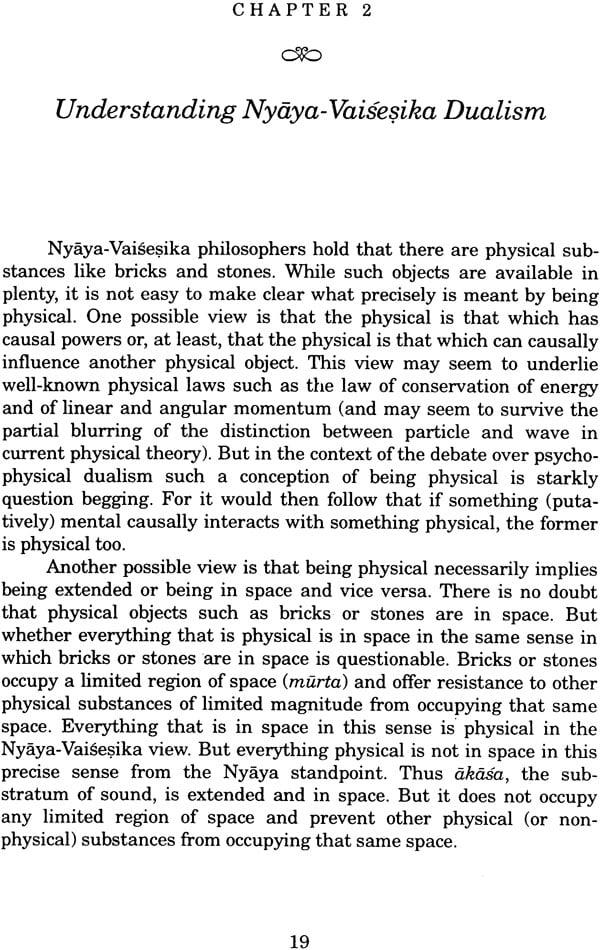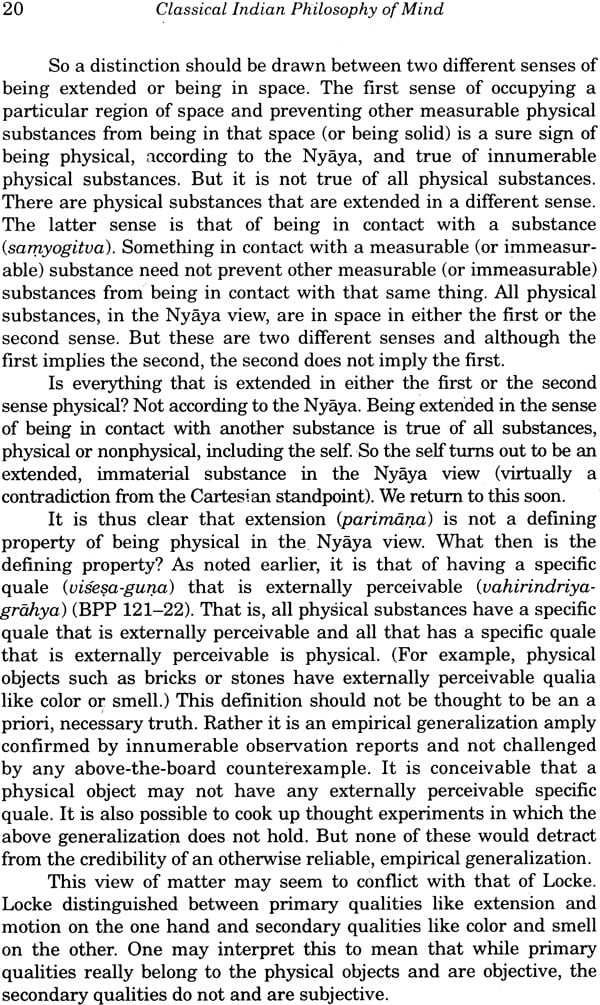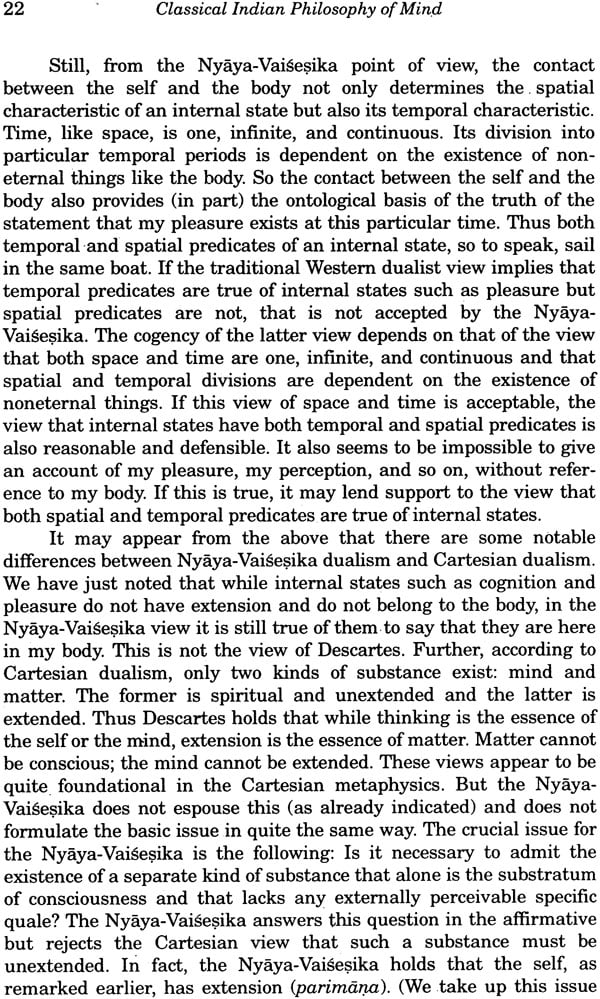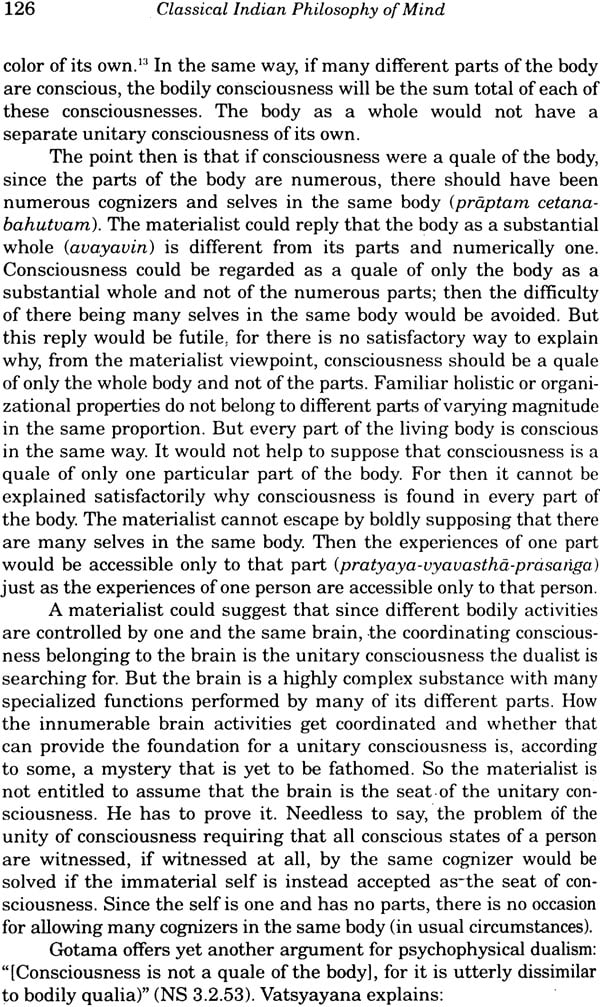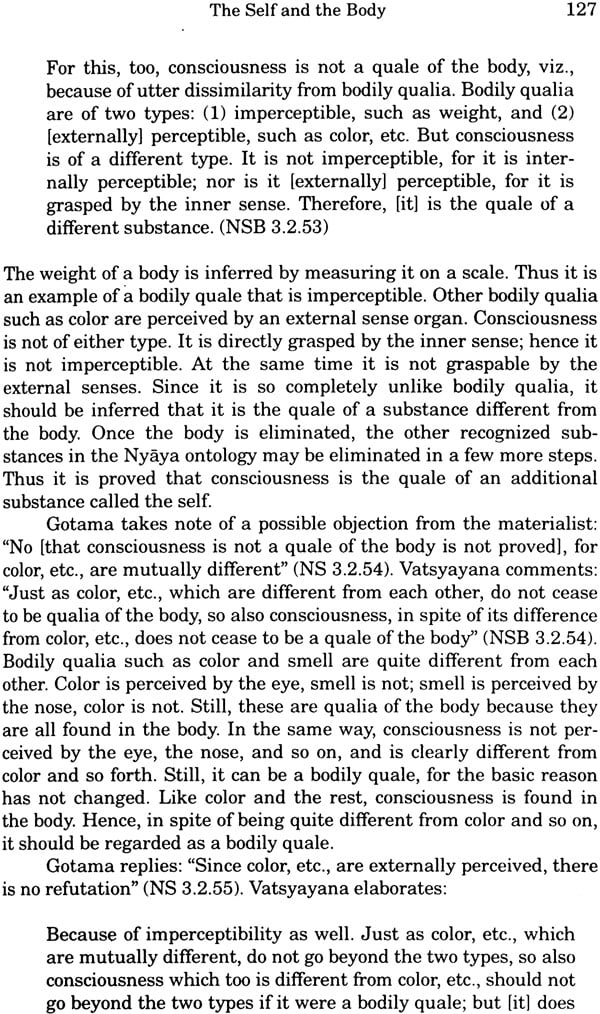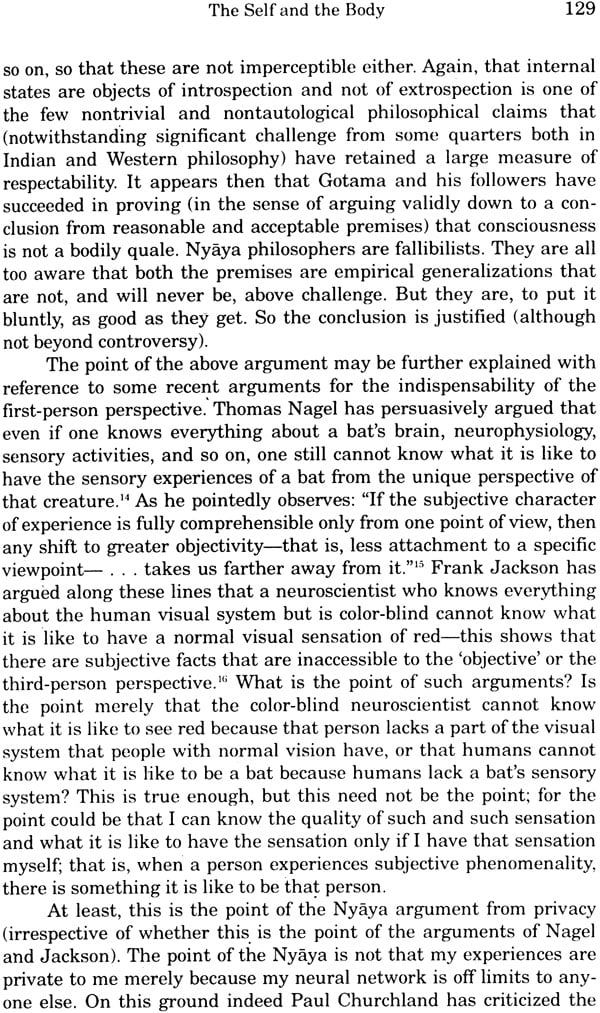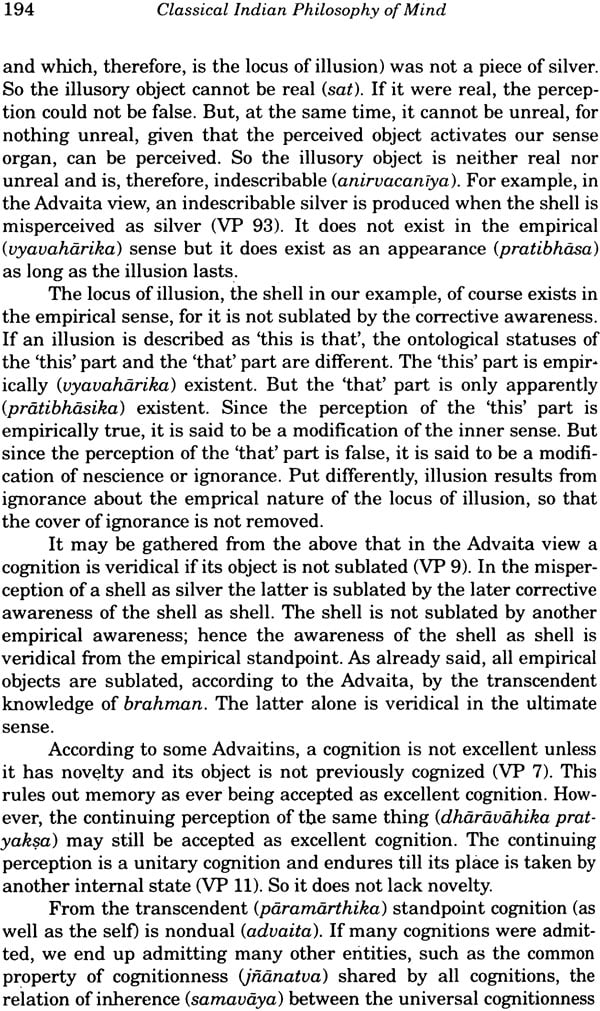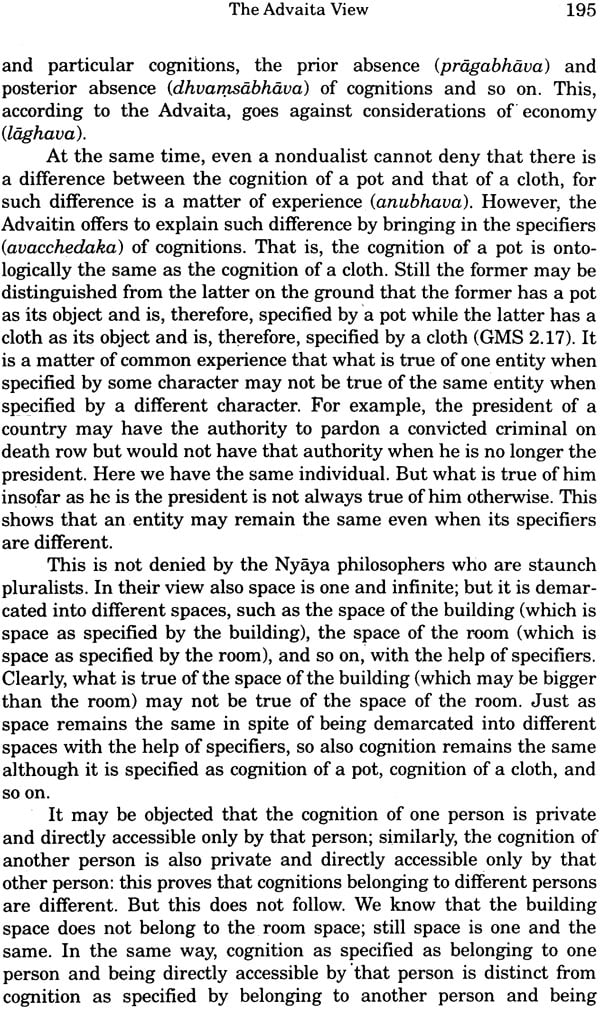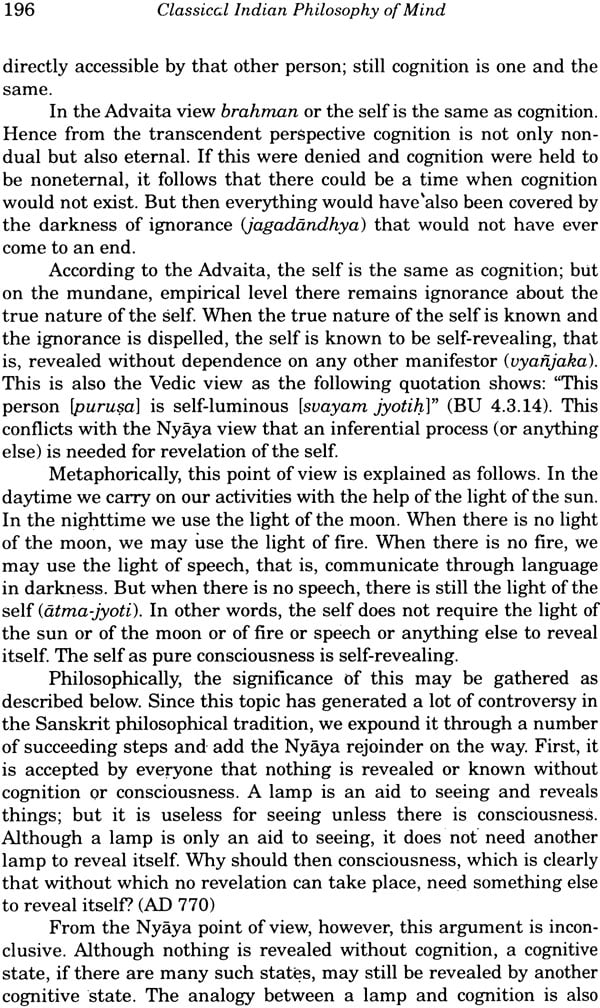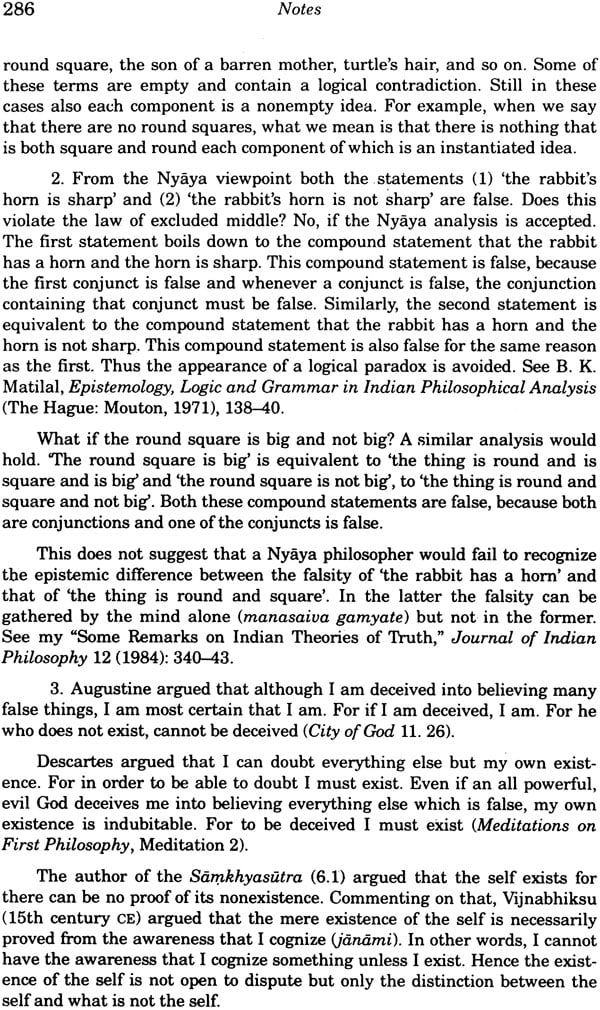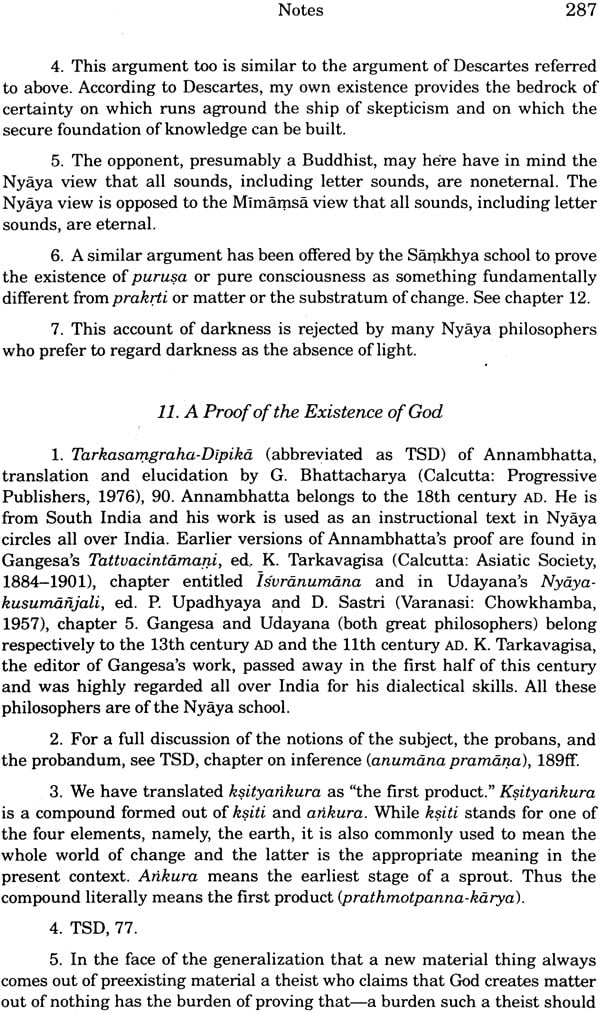
Classical Indian Philosophy of Mind: The Nyaya Dualist Tradition
Book Specification
| Item Code: | NAC961 |
| Author: | Kisor Kumar Chakrabarti |
| Publisher: | Motilal Banarsidass Publishers Pvt. Ltd. |
| Language: | English |
| Edition: | 2001 |
| ISBN: | 9788120817043 |
| Pages: | 329 |
| Cover: | Hardcover |
| Other Details | 8.9 Inch X 5.8 Inch |
| Weight | 560 gm |
Book Description
This book examines psycho-physical dualism as developed by the Nyaya school of Indian philosophy. Dualism is important to many world religions which promote personal immortality and to morality which promotes free will. For the Nyaya, the self is a permanent, immaterial substance to which non-physical internal states like cognition belong. This view is challenged by other Indian schools, especially the Buddhist and Carvaka schools.
Chakrabarti brings out the connections between the Indian and the Western debates over the mind body problem and shows that the Nyaya position is well developed, well articulated, and defensible. He shows that Nyaya dualism differs from Cartesian dualism and is not vulnerable to some traditional objections against the latter. A brief discussion of the Samkhya and the Advaita theories of the self and the critique of these views from the Nyaya standpoint are included, as well as a discussion of a classical Nyaya causal argument for the existence of God. The appendix contains an annotated translation of selected portions of Udayana’s masterpiece, Atmatattvaviveka (Discerning the Nature of the Self).
There are many books in English and other European languages in which classical Indian views of the self (atman) are discussed. But in none of them these views are presented in such a way that a reader who is not familiar with the original sources can see for himself that Indian philosophers have thoroughly and rigorously dealt with a wide range of issues in the philosophy of mind. Our work is the first attempt to fill this gap although in a very limited way. It is not a comprehensive work seeking to cover all major classical Indian philosophies of mind. Rather it is mainly devoted to selected topics pertaining to the Nyaya-Vaisesika (Nyaya for short) philosophy of mind. Besides the Nyaya, we have discussed the Carvaka, Buddhist, Samkhya, Advaita, and Cartesian views and offered criticisms of each of these from the Nyaya point of view. There are also references to some recent physicalist, functionalist and neo-Humean views and brief critiques of them. In the appendix we have provided an annotated translation of selected passages of Udayana’s masterpiece entitled Atmatattvaviveka, which is devoted to some key issues in the Nyaya philosophy of mind.
All the translations in this work are our own though we are not fully satisfied with them. Partly because of the great expressive power of Sanskrit and partly because we are dealing with great thinkers who have compressed a lot of thought into a very short space, the translation of Sanskrit philosophical works is often an enormously difficult task. A more thorough job would have involved adding alternative translations and more comments. But that would have required much more space than was available.
We should add a word about diacritical marks. We have used diacritical marks for Sanskrit words, titles of Sanskrit texts, and names of Sanskrit philosophical schools. But we have left them out of names of individuals, for some to whose names they would have been applicable, do not like them.
Our aim in this work is not that of using classical Indian sources to develop an original theory of mind or self. Nor is it our aim to provide a purely historical research in philosophy Accordingly, we are not concerned to compare different interpretations of historical texts or to trace historical developments. Our aim is partly historical. We seek to utilize fully the original source literature in Sanskrit, let the Indian theorists speak for themselves as far as practicable and with the help of our comments and interpretations provide our readers with access to Indian theories of the mind or self with the focus on the Nyaya dualist tradition, Our aim is to present the views of a major Indian school of philosophy in a clear and compelling way that should make it easy for a student of philosophy to understand and appreciate them. Our presentation should help our readers to situate the Indian accounts with respect to the relevant theories of Western philosophers. The Indian views are interesting in themselves and quite pertinent to Western philosophy, including contemporary discussions of mind and cognition. The Nyaya school in particular has worked out distinctive theories with original features, and these can contribute to current discussions. Our aim is to make this clear with the hope that this may motivate a future scholar to make more progress. Our aim is also to show that the Nyaya position is viable and defensible. This does not imply that the Nyaya is always right nor that it is immune to objection. However, this does imply that the Nyaya view is plausible and that it can be argued for. But we do not rule out that there are other viewpoints that are plausible and can be argued for, In fact, Vacaspati Misra, one of the greatest Indian philosophers, has written sympathetically and extensively on several different schools of Indian philosophy. If we get to write book length works on some other views, we shall try within our limitations, to emulate that to some extent.
In the course of discussing classical Nyaya dualism we have drawn attention to two logical principles. The first is that of general acceptability of inductive examples (GAIE). According to it, all examples brought in support or critique of an empirical generalization should be acceptable to both sides in a philosophical or scientific debate. This is formulated by Gotama, the founder of Indian logic, but is not explicitly mentioned by Aristotle, Bacon or Mill, the three main sources of European inductive logic. In certain areas of the study of induction Indian logic has been ahead of European logic. For example, the problem of induction is not discussed explicitly in Europe before Flume, but Indians have been discussing it for many centuries before that, as we have shown in Definition and Induction, (University of Hawaii Press, 1995). So the mere fact that GAIE is not well known in the European tradition should not he a ground for disregarding it. GAIE may be challenged just as even classical formal logical principles like the law of excluded middle may be challenged. However, more often than not something like GAIE is honored by empirical scientists who require independent verification of observations and experiments (whether confirming or disconfirming) offered in support of general claims that go beyond observation. GAIE is not toothless and can he effectively used by a dualist to build his case, as we have shown. A physicalist or a functionalist may not like this. But this should be a matter of interest to a physicalist or a functionalist, particularly if the latter happens to be pro-science. A logical principle which seems to work well for empirical sciences but seems to cause problems for a physicalist or a functionalist should make would-be physicalists or functionalists wonder if the principle is objectionable or irrelevant or if physicalism or functionalism are in need of reexamination.
It should not be thought that GAIE can be utilized only by a dualist and not by a physicalist. On the contrary, GAIE is a logical principle and can be utilized by both sides in a philosophical debate. We illustrate this below.
A dualist may offer the following argument: All colored things are unconscious; all living bodies are colored; so all living bodies are unconscious. If the conclusion is acceptable, it shows that consciousness does not belong to the body; a dualist may then with the help of other arguments press for the admission of a non-physical self as the conscious being. But whether the conclusion is acceptable depends on whether the general premise that all colored things are unconscious is acceptable. This premise is supported by examples like bricks and stones acceptable to both the dualist and the physicalist. The physicalist may offer living bodies as counterexamples. But living bodies are the subject of the conclusion and part of the bone of contention. So, given GAIE, living bodies do not qualify as counterexamples. The said premise thus becomes acceptable and GAIE is useful for that.
However, a physicalist may offer the following counter argument: All physical states are caused by physical causal conditions; all bodily states are physical states; hence all bodily states are caused by physical causal conditions. This counter argument is designed to forestall the dualist claim that bodily states like redness of the face can be caused by non-physical states like anger. But whether the conclusion is acceptable depends on whether the general premise that all physical states are caused by physical causal conditions is acceptable. This premise is supported by examples like the color of a mango changed by temperature that are acceptable to both the dualist and the physicalist. The dualist may offer bodily states like redness of the face or the clenching of fists caused by anger (which in the dualist view is a non-physical state) as counterexamples. But a physicalist may claim that anger is a bodily state and reject all such counterexamples. So, given GAIE, the said premise becomes acceptable and thus GAIE can be useful for a physicalist as well.
Accordingly, a philosophical dispute cannot be settled by GAIE alone. But other considerations can be brought in on a case by case basis to tilt the balance on one side. If confronted by the above counter argument, the dualist may try to show that the counter argument is not an equal match to the dualist argument. If the counter argument were an equal match to the dualist argument, the result would be a stalemate which would frustrate the dualist’s purpose. So a dualist may try to weaken the counter argument. One possible objection is that the conclusion that all bodily states are caused by physical causal conditions is acceptable to a dualist. The latter too accepts that for all bodily states physical causal conditions are necessary. The disagreement is over whether all the causal conditions of bodily states are exclusively physical. So the physicalist needs to show that all bodily states are caused by only physical causal conditions. For this to follow logically the first premise in the counter argument should be reformulated as that all physical states are caused by only physical causal conditions. Now the premise states the usual closure assumption of a physicalist.
A dualist may challenge the reformulated premise by suggesting that there is a divine being which is non-physical and conscious and a causal condition of all non-eternal things. If this is so, it is no longer true that physical states are caused by only physical causal conditions. Of course, a physicalist is likely to object to the suggestion that God exists. Proving the existence of God is also extremely controversial. (A proof is discussed in a later chapter.) Still the suggestion shows that the physicalist assumption that physical states have only physical causal conditions is open t challenge and needs to be argued for and not merely taken for granted.
A physicalist may retort that if a dualist throws in God to challenge the reformulated premise a physicalist may also suppose for the sake of argument that everything is conscious. Then the dualist would be robbed of supporting examples for his premise that all colored things are unconscious. The dualist has offered examples like bricks and stones to support the induction. But if bricks and so on are conscious, no undisputable examples can be found.
Such a retort, however, does not really help a physicalist. The latter is committed to the position that there are physical things and that at least some of them are unconscious. To suppose that even bricks and stones are conscious contradicts the physicalist thesis. This invites the ground of defeat called pratijna-virodha or contradicting the thesis. But the supposition of the existence of God is not inconsistent with the dualist position. So by throwing in that suggestion the dualist is not guilty of contradicting his thesis.
Besides the suggestion of the existence of God the dualist may argue that space and time are among the causal conditions of all physical states. But if space and time are infinite and continuous quantities and lack any specific quale that are externally perceptible, neither space nor time are physical in the usual Nyaya sense (explained in the first chapter) that all that is physical possesses an externally perceptible specific quale. Accordingly, the physicalist assumption that physical states have only physical causal conditions is questionable on that ground.
A physicalist may disagree and argue either that space and time are not causal conditions or argue that they are physical. But such claims are controversial and may be challenged by the dualist. Until some progress is made in resolving the debate over the nature of space and time and the concept of the physical, the dualist remains entitled to point out that the assumption that physical states have only physical causal conditions is questionable. This weakens the counter argument and prevents it from being an equal match of the dualist argument.
Even in the unlikely scenario that a physicalist is able to quash the objections from the suggestions that God or space or time are non-physical causal conditions of physical states, it is unclear how a physicalist can justify the claim that nothing non- physical is or can be a causal condition of something physical. This negation is contained in the assumption that physical states have only physical causal conditions. Until the negation is justified, the counter argument cannot be an equal match of the dualist argument. Thus not GAIE alone but GAIE combined with other suitable arguments and methods can help to tilt the balance in favor of the dualist. GAIE is an important methodological principle and may be used to build the case for a wide range of philosophical theories. Still a Nyaya dualist is able to take full advantage of it primarily because the Nyaya is a fully developed philosopical system. It is the greatness of that system that speaks volumes for Nyaya dualism.
The other logical principle alluded to above may he called the flaw of uniqueness. This implies that a unique property of an inferential subject (paksa) is logically (from the viewpoint of observational co-relation) inadequate (the issue is not one of merely formal validity) to prove that something else is true or false of that subject. Recent physicalists and functionalists have argued that although no other physical states are subject to privileged access the brain states are so because of their greater and unique complexity. We have pointed out that, irrespective of whether brain states are uniquely more complex than any other physical states, this argument may have a flawed inductive structure. There is room for deep disagreement over these logical principles (which go beyond the controversy over dualism) and this, we hope, will mean an invitation to all concerned to think.
I happily acknowledge my debt to the anonymous readers appointed by the publisher for valuable comments. I am also grateful to John Kearns, Michael Ferejohn, Owen Flanagan, William Lycan, Jay Rosenberg, Adam Constaberas, Tushar Sarkar, Sukharanjan Saha and Jay Garfield for reading parts of the manuscript and giving useful suggestions. My homage goes to my teachers of Indian philosophy: late Pt. Madhusudana Nyayacharya, late Pt. Pancanana Sastri, late Pt. Narmada Tarkatirtha, Pt. Visvabandhu Tarkatirtha, late Gopinath Bhattacharya, Narayana Chandra Goswami and Ashoke Kumar Gangopadhyaya. I thank Sukanya (daughter) and most of all Chandana (wife) for drawing attention to unclarities and offering sympathetic criticisms. I also thank Nancy Ellegate, Diane Ganeles, Nancy Farrell, and the anonymous copyeditor of Suny Press for help with the publication of this work.
Psychophysical dualism is the theory that mind and matter are ontologically different and are not reducible to each other. Such a theorist may hold that both material and mental entities are there for all the time. Or such a theorist may hold that either material or mental entities come first. In the currently popular scientific picture of the origin of the solar system our mother Earth was separated from the Sun in a distant past and was then devoid of all life and consciousness, for it was too hot and lacked the atmosphere requisite for the origin and sustenance of life. Gradually the Earth cooled down over millions of years and life evolved slowly from the humblest beginnings to the most complex found today in the form of human beings. This scientific account is compatible with dualism and, in particular, with the Nyaya-Vaisesika dualism that is the subject of our study The Nyaya-Vaisesika holds that a living body is a necessary condition for the origin of conscious states. It follows therefrom that no conscious states can exist if there are no living bodies. It is worth noting that the Biblical and the Koranic accounts of genesis speak of relatively short periods of time spanning over several thousand years, which is at odds with the scientific estimate. But the Hindu accounts of genesis with which the Nyaya-Vaisesika is familiar, usually speak of vast expanses of time to estimate the periods of creation (srsti). They also usually speak of states of dissolution (pralaya) when there is water and other kinds of matter but no animals or plants (and no conscious states belonging to any animals or plants). Since the Nyaya-Vaisesika dualism fits such Hindu accounts of genesis that are not at odds with the current scientific account, the former is also not at odds with the latter.
For a study of this dualism we begin with a brief outline of Nyaya-Vaisesika philosophy. According to the standard view (there are other views having a smaller following within the Nyaya-Vaisesika tradition), there are seven kinds of reals called substance (dravya), qualia (guna), action (karma), universal (samanya), ultimate individuater (visesa), inherence (samavaya), and negative entities (abhava). A substance is the substratum (asraya) of qualia and actions in the sense that it is something in which there cannot be any absolute absence (atyantabhava) of the latter. A substance is a continuant and different from its qualia and actions: it may remain the same even when its qualia or actions change. For example, a mango as a substance may remain the same even when its color (a quale) has changed from green to yellow or even when it starts to roll down (a kind of action) after being stationary before. Qualia and actions are often perceptible and if so, the substance to which they belong may also be perceptible. This differs from Locke’s view that a substance is imperceptible. That is, in the Nyaya view, not only the yellow or green color of the mango but also the mango is perceived. However, it may be noted that though, in the Nyaya view, a substance may be perceptible if its qualia or actions are perceptible, it is not always so. For example, in the view of many Nyaya philosophers the self (atman) is an imperceptible substance though it possesses perceptible qualia like cognition or desire.
The Nyaya admits five kinds of physical substance called earth, water, fire, air, and akasa (the substratum of sound). These are physical (bhautika) substances in the sense that each possesses a specific quale that is externally perceivable (e.g., earth has smell). Of these the first four are ultimately atomic (anu) and the last is non- atomic and pervasive (vibhu). The self is a spiritual (cetana) substance radically different from all of them, for it alone is the substratum of consciousness and lacks any externally perceivable features. Further, the self is both beginningless and endless. We shall later discuss the reasons for these views. But it may be noted that the admission of eternal, spiritual substances is not ruled out by the current scientific account of the origin of the species or of the planetary system. The scientific picture is not concerned with anything that is nonphysical or spiritual, does not, either endorse or oppose it and is not interested in whether such entities, if they exist, are eternal or not. As already said, a dualist who holds that conscious states (which are ephemeral) do not exist except when there are living bodies does not contradict the scientific view.
There is also no inconsistency in holding that although the self is a spiritual substance, it can exist devoid of all consciousness. While the qualia depend on the substance, the reverse is not true (in the view of the Nyaya and many other pro-substance philosophers). Accordingly, although the conscious states are qualia and need the self as their support, the self can exist without them. Further, the radical difference between the self and the physical substances is not wiped out when the self is devoid of consciousness. It still remains true, as the Nyaya would argue, that there is absolute absence of consciousness in the physical substances but not in the self.
Besides the self and the five physical substances the Nyaya also admits three other kinds of substance. The first two of these are space (dik) and time, each of which is one, infinite, and continuous. These two do not possess any externally perceivable specific quale. So they are not ‘physical’ insofar as being physical is to be understood in terms of having some externally perceivable specific quale. They are both imperceptible. They are nevertheless inferred as two of the common (sadharana) causal conditions without which nothing non- eternal can come into being.
The last remaining kind of substance is the inner sense (manas). The inner sense is imperceptible but is inferred to account for the direct awareness of internal states like pleasure. It is also inferred to account for the fact that there are occasions when although two or more perceptions could arise at the same time only one does. The inner sense is an indispensable instrument (karana) just as an external sense organ like the eye is an indispensable instrument. Accordingly, the inner sense is not the cognizer or the thinker that provides the ground of our personal identity. It is not the owner of the internal states; the latter belong only to the self. The inner sense too is not a ‘physical’ substance in the traditional Nyaya-Vaisesika sense, for it too lacks any externally perceivable specific quale.
Although space, time, and the inner sense are not physical, they are not spiritual either, for there is absolute absence of consciousness in them. This is why the self radically differs from these as well.
Qualia are features of a substance that do not primarily generate motion and are as particular as the substances to which they belong. Examples are color, smell, and the like. In the Nyaya view the particular red color of a particular mango is causally dependent on and inheres in that mango and cannot belong to anything else. Thus guna is always a particular though it instantiates universals. For example, the particular red color of a certain mango is an instance of the universal redness that is the common property of all particular red colors. The universal redness (raktatva) is ontologically different from particular red colors (rakta-rupa-vyakti) that too are ontologically different from the substances. Since gunas are non- repeatable features, we call them (for the lack of anything better) qualia (without implying that they are always mental) and not qualities or properties as they are sometimes called, for qualities or properties are repeatable features. Thus qualia are quality particulars and not quality universals. Among the qualia are cognition, desire, and so on, regarded as qualia of the self. These will be studied in chapters 3 and 4.
Actions are features of a substance that primarily generate motion (resulting in conjunction with or disjunction from other substances). Like qualia they are as particular as the substances to which they belong and for the same reason. That is, an action is causally dependent on and inheres in the particular substance to which it belongs and, therefore, cannot belong to any other substance.
All substances, qualia, and actions are particulars. But they possess recurrent properties that are shared by other substances, qualia, or actions. These recurrent properties shared by many particulars are the universals. Examples are cowness and greenness. Universals are not mere concepts or names. They are objective, independent of the particulars that share them and are, in fact, changeless and eternal. But unlike Platonic Ideas they are not in some sense transcendent exemplars that can only be grasped by the reason and that particulars can only approximate. In the Nyaya view the particulars are as real as the universals themselves. The latter are present in the former and (if the particular loci are perceptible) are perceptible as well. For example, cowness is perceptible as are individual cows and redness is perceptible as are particular red colors.
Sometimes two particulars cannot be found to be different in any recognizable way although they have already been accepted to be different on substantial grounds. Such may be the case with two atoms that may be indiscernible in every respect but that are known to be different on the very grounds that prove their existence. In these cases ultimate individuators (visesa) are inferred to keep the eternal substances concerned distinct (the reasoning involves an application of Leibniz’s law of identity of indiscernibles).
| Preface | xi | |
| Acknowledgments | xvii | |
| Abbreviations | xix | |
| 1. | Introduction | 1 |
| 2. | Understanding Nyaya-Vaisesika Dualism | 19 |
| 3. | Cognition | 31 |
| 4. | Other Internal States | 45 |
| 5. | The Existence and Permanence of the Self | 55 |
| 6. | The Self as a Substance | 79 |
| 7. | The Self and the External Sense Organs | 93 |
| 8. | The Self and the Inner Sense | 103 |
| 9. | The Self and the Body | 115 |
| 10. | Miscellaneous Arguments | 147 |
| 11. | A Nyaya Causal Proof of the Existence of God | 159 |
| 12. | The Samkhya View and the Nyaya Critique | 175 |
| 13. | The Advaita View and the Nyaya Critique | 191 |
| 14. | Conclusion | 207 |
| Appendix: | An Annotated Translation of Atmatattvaviveka | 219 |
| Notes | 277 | |
| Selected Bibliography | 293 | |
| Index | 305 |
